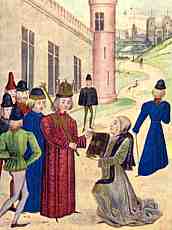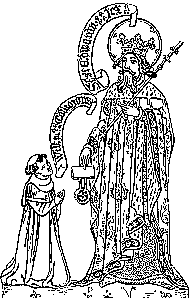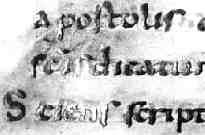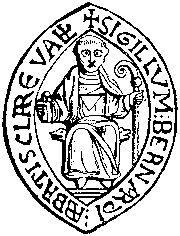
Froissart
presents a volume of his love poetry to Richard II.





Seal
of St Bernard of Clairvaux.
| Decoration | |||||
| Manuscripts were always items of high social value. They represented the value of learning. They were laborious to produce. They required expensive materials. As such, they were prestige goods in their own right and conferred status on their owners. It is only to be expected that extra attention might be lavished on their craftsmanship. |  |
||||
|
Froissart
presents a volume of his love poetry to Richard II. |
|||||
| The term decoration might be taken to imply something insignificant, the icing on the more important cake. However, all forms of decoration on a medieval manuscript were significant in some way; as aids to comprehension, as symbols of status or significance or authority, as signifiers of the relative weight to be accorded to different parts of the manuscript. | |||||
 |
Even legal documents which might be regarded as purely functional recorded rights or transactions of social significance. The prestige associated with a granted privilege or a purchased asset should be reflected in some way in the document authenticating it. | ||||
| A 15th century stained glass window in Great Malvern, Worcestershire, commemorates the presentation of a charter to the church by Edward the Confessor. The appearance of the document relates to its significance, represented by the huge seal dangling from it. | |||||
| There were various ways of enhancing a document, and different forms of enhancement were favoured at different times and for different classes of document. It could be in the form of the writing itself, elaborate and carefully written calligraphy battling it out over the centuries with the necessity for speed of transcription being two significant factors in the continuing development of script styles. A charter from the king could be expected to be more exquisitely penned than the manorial accounts. | |||||
 |
|||||
| The extravagant calligraphy of a diploma of Emperor Konrad III from 1139 (St Gall, Stiftsarchiv). (From Steffens 1929) | |||||
| Expensive or prestige materials could be used in the production of a manuscript. Silver or gold lettering were favoured in some areas in the early medieval period for especially swank documents. Silver lettering on purple dyed vellum had favour in Byzantium, gold lettered text for the most valued documents among the Carolingians. In the later medieval period gold leaf was used on initial letters and in miniatures, putting the illumination into illuminated manuscripts. |
 |
||||
| The 10th century New Minster Charter (British Library, Cotton Vespasian A VIII) was written in gold ink. By permission of the British Library. | |||||
| A lectionary on purple vellum from the Bibliothèque Nationale de France (Manuscripts Department, Western Section, Lat 9451) is displayed in the "Creating French Culture" exhibition. The Canterbury "Codex Aureus" Inscription shows an exquisite page of an Anglo-Saxon manuscript with a gold heading script. | |||||
 |
Miniatures, historiated initials and decorative borders were not just for edification and decorative effect. They were expensive of labour and material to produce and were part of what made manuscripts prestigious. From the manic and intricate swirls of the Book of Kells to the lush richness of the Tres Riches Heures du Duc de Berry, painted decoration has defined the most desirable manuscripts. Sometimes the people who illustrate them for us seem to forget that they also have a text. | ||||
| Hand painted historiated initial illustrating St Ursula on a leaf from an early printed book, by permission of the University of Tasmania Library. | |||||
| A decorative page from the Book of Kells. The calendar page for August from the Tres Riches Heures du Duc de Berry is displayed by the Louvre Webmuseum. | |||||
| The various forms of decoration not only enhanced books and documents for their medieval owners, they are useful to historians for establishing provenance and dating. A quick peep at the initials and borders can enhance your reputation as a paleographical dating expert if all the letters are starting to look the same. | |||||
| The bindings of a book also indicate its social value. There are examples of incredibly elaborate bookbindings in such exotic materials as carved ivory for highly prestige volumes, while the more usual fine tooled leather made books important. A large proportion of surviving manuscript books have been rebound since the middle ages, but original bindings do exist. (See Szirmai 2000) | |||||
| The seals used to authenticate all letters and legal documents had a serious practical function in the legal process. They were also an art form in their own right. They conferred prestige to a document and its owner and sometimes told a story about the owner, individual or corporate, of the seal. |
 |
||||
|
Seal
of St Bernard of Clairvaux. |
|||||
| So when we examine some of the decorative aspects of manuscripts, we are not dealing with frivolities. We are looking at the formal qualities which contribute to function and significance. We are also looking at other aids to reading the text, apart from the squiggly black lines of letters. | |||||
|
If you
are looking at this page without frames, there is more information about
medieval writing to be found by going to the home
page (framed) or the site map (no
frames). |
|||||